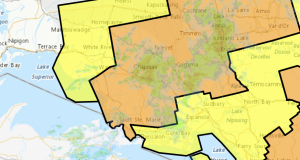 Members from the Sault Ste Marie Detachment of the Ontario Provincial Police (OPP) wants to ensure, that the public practices proper ice safety. Many lakes and rivers in the area may have a thin layer of ice, but with the milder weather are still not safe to venture onto. Residents must take caution regarding thin ice conditions on area waterways.
Members from the Sault Ste Marie Detachment of the Ontario Provincial Police (OPP) wants to ensure, that the public practices proper ice safety. Many lakes and rivers in the area may have a thin layer of ice, but with the milder weather are still not safe to venture onto. Residents must take caution regarding thin ice conditions on area waterways.
Many factors affect ice thickness including:
- Type of water
- Time of year
- Water depth and size of body of water
- Currents, tides, and other moving water
- Logs, rocks, and shoals absorbing heat from the sun
- Changing air temperature
Ice does not freeze at uniform thickness throughout the body of water. When ice forms early and may look safe, it is likely not thick, strong, or stable enough to support much weight. Thickness should be checked regularly as you move further onto the ice.
Anyone considering venturing out on ice covered bodies of water for recreational activities should do so with an experienced outdoor enthusiast who is familiar with local conditions and water currents. Children should not play near or on ice covered bodies of water unless supervised by an experienced, safety-conscious person.
Remember “No ice is safe ice“, venturing out onto unsafe ice puts your life and those of the first responders at risk”.
From the Red Cross
Color and Depth
The colour of ice may be an indication of its strength − clear blue to black ice is strongest, and likely the deepest. You should only skate on ice that is 20+ cm thick. White opaque or snow ice should be avoided. Grey ice indicates the presence of water and is unsafe to stand on.
Location
Ice thickness is never consistent. The weakest ice will be in the center and along the edge of the water. Avoid streams and flowing water, even if they look frozen. Avoid ice that has recently frozen, thawed, and then frozen again. The safer place to skate is on a still body of water, such as a lake.
Weather
Canada is prone to fluctuating weather conditions. Consistent air temperatures below freezing make for safer, stronger ice. Swings above zero can compromise the integrity of ice by melting existing ice or changing the water level, leaving unsafe spots in both the centre and shoreline of a lake.
Safety
When spending time on the ice, you should always be prepared for the worst-case scenario and have an emergency plan. If you get into trouble on ice and you’re by yourself:
- Call for help. Resist the immediate urge to climb back out where you fell in. The ice is weak in this area.
- Try to relax and catch your breath. Turn yourself toward shore so you are looking at where you entered onto the ice. The ice is more stable close to shore.
- Reach forward onto the broken ice without pushing down. Kick your legs to try to get your body into a horizontal position. Continue kicking your legs, and crawl onto the ice.
- When you are back on the ice, crawl on your stomach or roll away from the open area with your arms and legs spread out as far as possible to evenly distribute your body weight. Do not stand up! Look for shore and make sure you are crawling in the right direction.
Rescuing another person from ice can be dangerous. The safest way to perform a rescue is from shore:
- Call for help. Consider whether you can quickly get help from trained professionals (police, firefighters or ambulance) or bystanders.
- Check if you can reach the person using a long pole or branch from shore – if so, lie down and extend the pole to the person.
- If you go onto ice, wear a PFD and carry a long pole or branch to test the ice in front of you. Bring something to reach or throw to the person (e.g. pole, weighted rope, line or tree branch).
- When near the break, lie down to distribute your weight and slowly crawl toward the hole. Remaining low, extend or throw your emergency rescue device (pole, rope, line or branch) to the person.
- Have the person kick while you pull them out.
Additionally, avoid vehicles on the lake as they can cause shock waves, or may not be able to safely stop. Make sure kids are always under supervision and keep pets on a leash.
Have fun!
When you’re bundled up and prepared for the weather, ice activities are a great way to get exercise and have fun. By following the few tips above, you’re on the right track to enjoy the winter season to its fullest.
And remember, just because you’re frozen, doesn’t mean the ice is too.
- East Algoma OPP – Driver charged with Impaired Driving after Complaint - December 27, 2025
- North East OPP – Winter Driving Advisory - December 25, 2025
- Schreiber OPP – Arrest made after drug trafficking investigation - December 24, 2025
 Wawa-news.com You can't hear the 'big picture'!
Wawa-news.com You can't hear the 'big picture'!
